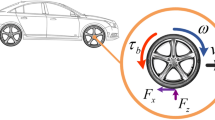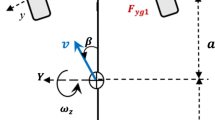Abstract
The purpose of the antilock braking system (ABS) is to regulate the wheel longitudinal slip at its optimum point in order to generate the maximum braking force; however, the vehicle braking dynamic is highly nonlinear. To relax the requirement of detailed system dynamics, this paper proposes an intelligent exponential sliding-mode control (IESMC) system for an ABS. A functional recurrent fuzzy neural network (FRFNN) uncertainty estimator is designed to approximate the unknown nonlinear term of ABS dynamics, and the parameter adaptation laws are derived in the sense of projection algorithm and Lyapunov stability theorem to ensure the stable control performance. Since the outputs of the functional expansion unit are used as the output weights of the FRFNN uncertainty estimator, the FRFNN can effectively capture the input–output dynamic mapping. In addition, a nonlinear reaching law, which contains an exponential term of sliding surface to smoothly adapt the variations of sliding surface, is designed to reduce the level of the chattering phenomenon. Finally, the simulation results demonstrate that the proposed IESMC system can achieve robustness slip tracking performance in different road conditions.













Similar content being viewed by others
Explore related subjects
Discover the latest articles, news and stories from top researchers in related subjects.References
Tan HS, Tomizuka M (1990) Discrete-time controller design for robust vehicle traction. IEEE Control Syst Mag 10(3):107–113
Johansen TA, Petersen I, Kalkkuhl J, Ludemann J (2003) Gain-scheduled wheel slip control in automotive brake systems. IEEE Trans Control Syst Technol 11(6):799–811
Oniz Y, Kayacan E, Kaynak O (2009) A dynamic method to forecast the wheel slip for antilock braking system and its experimental evaluation. IEEE Trans Syst Man, Cybern, Part B 39(2):551–560
Kayacan E, Kaynak O (2009) A grey system modeling approach for sliding mode control of antilock braking system. IEEE Trans Ind Electron 56(8):3244–3252
Yi J, Alvarez L, Horowitz R (1992) Adaptive emergency braking control with underestimation of friction coefficient. IEEE Trans Control Syst Technol 10(3):381–392
Nešić D, Mohammadi A, Manzie C (2013) A framework for extremum seeking control of systems with parameter uncertainties. IEEE Trans Autom Control 49(8):1292–1302
Jing H, Liu Z, Chen H (2011) A switched control strategy for antilock braking system with on/off valves. IEEE Trans Veh Technol 60(4):1470–1484
Khanesar MA, Kayacan E, Teshnehlab M, Kaynak O (2012) Extended Kalman filter based learning algorithm for type-2 fuzzy logic systems and its experimental evaluation. IEEE Trans Ind Electron 59(11):4443–4455
Sharkawy AB (2010) Genetic fuzzy self-tuning PID controllers for antilock braking systems. Eng Appl Artif Intell 23(7):1041–1052
Wang WY, Li IH, Chen MC, Su SF, Hsu SB (2009) Dynamic slip-ratio estimation and control of antilock braking systems using an observer-based direct adaptive fuzzy-neural controller. IEEE Trans Ind Electron 56(5):1746–1756
Topalov AV, Oniz Y, Kayacan E, Kaynak O (2011) Neuro-fuzzy control of antilock braking system using sliding mode incremental learning algorithm. Neurocomputing 74(11):1883–1893
Hsu CF, Kuo TC (2014) Adaptive exponential-reaching sliding-mode control for antilock braking systems. Nonlinear Dyn 77(3):993–1010
Poursamad A (2009) Adaptive feedback linearization control of antilock braking systems using neural networks. Mechatronics 19(5):763–773
Lin CM, Li HY (2013) Intelligent hybrid control system design for antilock braking systems using self-organizing function-link fuzzy cerebellar model articulation controller. IEEE Trans Fuzzy Syst 21(6):1044–1055
Tong SC, Li HX (2003) Fuzzy adaptive sliding-mode control for MIMO nonlinear systems. IEEE Trans Fuzzy Syst 11(3):354–360
Hsu CF (2013) Adaptive neural complementary sliding-mode control via functional-linked wavelet neural network. Eng Appl Artif Intell 26(4):1221–1229
Hsu CF (2014) Intelligent total sliding-mode control with dead-zone parameter modification for a DC motor driver. Control Theory Appl 8(11):916–926
Wang LX (1994) Adaptive fuzzy systems and control: design and stability analysis. Prentice-Hall, Englewood Cliffs
Tong SC, Li HX, Chen GR (2004) Adaptive fuzzy decentralized control for a class of large-scale nonlinear systems. IEEE Trans Syst, Man, Cybern, Part B 34(1):770–775
Londhe PS, Patre BM, Tiwari AP (2014) Design of single-input fuzzy logic controller for spatial control of advanced heavy water reactor. IEEE Trans Nucl Sci 61(2):901–911
Lin FJ, Hung YC, Hwang JC, Chang IP, Tsai MT (2012) Digital signal processor-based probabilistic fuzzy neural network control of in-wheel motor drive for light electric vehicle. IET Electr Power Appl 6(2):47–61
Wai RJ, Shih LC (2012) Adaptive fuzzy-neural-network design for voltage tracking control of a DC–DC boost converter. IEEE Trans Power Electron 27(4):2104–2115
Lin CM, Li HY (2014) Intelligent control using wavelet fuzzy CMAC backstepping control system for two-axis linear piezoelectric ceramic motor drive systems. IEEE Trans Fuzzy Syst 22(4):791–802
Han SI, Lee KS (2010) Robust friction state observer and recurrent fuzzy neural network design for dynamic friction compensation with backstepping control. Mechatronics 20(3):384–401
Mon YJ, Lin CM (2012) Supervisory recurrent fuzzy neural network control for vehicle collision avoidance system design. Neural Comput Appl 21(8):2163–2169
Lin YY, Chang JY, Lin CT (2013) Identification and prediction of dynamic systems using an interactively recurrent self-evolving fuzzy neural network. IEEE Trans Neural Netw Learn Syst 24(2):310–321
Wai RJ, Lin YW (2013) Adaptive moving-target tracking control of a vision-based mobile robot via a dynamic petri recurrent fuzzy neural network. IEEE Trans Fuzzy Syst 21(4):688–701
Chakravarty S, Dash PK (2012) A PSO based integrated functional link net and interval type-2 fuzzy logic system for predicting stock market indices. Appl Soft Comput 12(2):931–941
Wu CF, Lin CJ, Lee CY (2012) Applying a functional neuro-fuzzy network to real-time lane detection and front-vehicle distance measurement. IEEE Trans Syst, Man, Cybern, Part C 42(4):577–589
Hsu CF (2013) A self-evolving functional-linked wavelet neural network for control applications. Appl Soft Comput 13(11):4392–4402
Lin FJ, Teng LT, Lin JW, Chen SY (2009) Recurrent FL-based fuzzy neural network controlled induction generator system using improved particle swarm optimization. IEEE Trans Ind Electron 56(5):1557–1577
Lin HY, Lin CJ, Wu CF (2012) A hybrid of differential evolution and cultural algorithm for recurrent functional neural fuzzy networks and its applications. Int J Fuzzy Syst 14(4):519–529
Rubio JJ, Torres C, Rivera R, Hernandez CA (2011) Comparison of four mathematical models for braking of a motorcycle. IEEE Lat Am Trans 9(5):630–637
Slotine JJE, Li WP (1991) Applied nonlinear control. Prentice-Hall, Englewood Cliffs
Lin CM, Hsu CF, Chen TY (2012) Adaptive fuzzy total sliding-mode control of unknown nonlinear systems. Int J Fuzzy Syst 14(3):434–443
Juang CF, Chen JS (2006) Water bath temperature control by a recurrent fuzzy controller and its FPGA implementation. IEEE Trans Ind Electron 53(3):941–949
Juang CF, Chen JS (2007) A recurrent fuzzy-network-based inverse modeling method for a temperature system control. IEEE Trans. Syst, Man, Cybern, Part C 37(3):410–417
Rubio JJ (2014) Evolving intelligent algorithms for the modelling of brain and eye signals. Appl Soft Comput 14(B):259–268
Reducindo I, Santana ERA, Delgado DUC, Alba A (2014) Registration of multimodal medical images by particle filter: evaluation and new results. IEEE Lat Am Trans 12(2):129–137
Ye J (2014) Compound control of a compound cosine function neural network and PD for manipulators. Int J Control 87(10):2118–2129
Rubio JJ (2014) Analytic neural network model of a wind turbine. Soft Comput. doi:10.1007/s00500-014-1290-0
Fallaha CJ, Saad M, Kanaan HY, Al-Haddad K (2011) Sliding-mode robot control with exponential reaching law. IEEE Trans Ind Electron 58(2):600–610
Rubio JJ (2014) Adaptive least square control in discrete time of robotic arms. Soft Comput. doi:10.1007/s00500-014-1300-2
Hsu CF, Kuo TC (2014) Intelligent complementary sliding-mode control with dead-zone parameter modification. Appl Soft Comput 23(1):355–365
Li Y, Tang Z, Zhan Y (2014) Two-dimensional bilinear preserving projections for image feature extraction and classification. Neural Comput Appl 24(3):901–999
Acknowledgments
The authors are grateful to the reviewers for their valuable comments. The authors appreciate the partial financial support from the Ministry of Science and Technology of Republic of China under Grant MOST 103-2221-E-032-063-MY2.
Author information
Authors and Affiliations
Corresponding author
Rights and permissions
About this article
Cite this article
Hsu, CF. Intelligent exponential sliding-mode control with uncertainty estimator for antilock braking systems. Neural Comput & Applic 27, 1463–1475 (2016). https://doi.org/10.1007/s00521-015-1946-4
Received:
Accepted:
Published:
Issue Date:
DOI: https://doi.org/10.1007/s00521-015-1946-4




